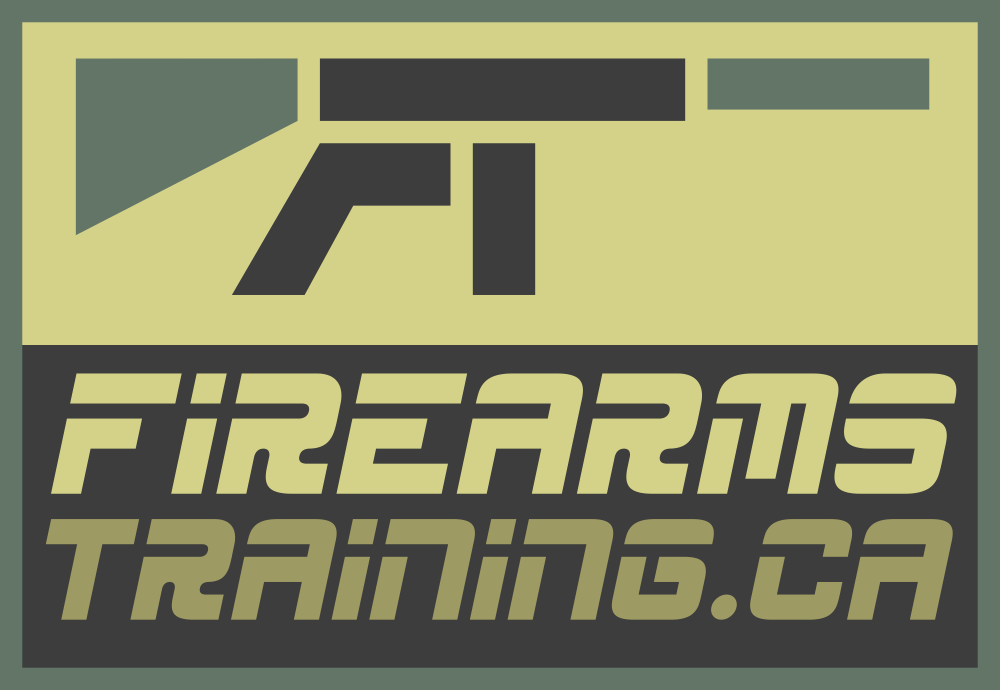
Home Page
Introduction
Licence Types
Firearms Types
Course Description
Is it mandatory
About the Exam
Acts & Prove
Schedule
Instructors
Items of Interest
PAL Application Form
Foreign Visitors
Airguns
Antique Guns
Unwanted Guns
Gun Verification
Transport Permits
IPSC Coaching
Links
Product Reviews
© Copyright
Firearms Training
Review of the Norinco NP28 Pistol
 In 2002 a friend bought a 1911 style
wide-body Norinco NP28 in 9mm Luger to get started in IPSC Standard
Division Competition and to dabble in ISSF bullseye competition. Buying
this handgun is certainly a cheap way to start shooting. At $350
Canadian (not that Americans are allowed to import Norinco handguns)
you get a lot of pistol for the money. You get the pistol, two
magazines and a plastic carry case (that doesn't have room for most
locking devices) and a very slim owners manual. In countries that trust
their citizens, this gun's magazine capacity is 15 shots, in Canada the
magazines come with a riveted baseplate and are blocked to 10
rounds.
In 2002 a friend bought a 1911 style
wide-body Norinco NP28 in 9mm Luger to get started in IPSC Standard
Division Competition and to dabble in ISSF bullseye competition. Buying
this handgun is certainly a cheap way to start shooting. At $350
Canadian (not that Americans are allowed to import Norinco handguns)
you get a lot of pistol for the money. You get the pistol, two
magazines and a plastic carry case (that doesn't have room for most
locking devices) and a very slim owners manual. In countries that trust
their citizens, this gun's magazine capacity is 15 shots, in Canada the
magazines come with a riveted baseplate and are blocked to 10
rounds.
 As there is no detailed information
available for this model on the internet, I talked with Roger Kotanko
of Dark International
Trading Company, one of the Canadian distributors for Norinco, to
get some background information on this model.
As there is no detailed information
available for this model on the internet, I talked with Roger Kotanko
of Dark International
Trading Company, one of the Canadian distributors for Norinco, to
get some background information on this model.
Roger is a very capable pistolsmith, who has rebuilt a couple of 38 Super race guns for me. In his experience the Norinco's internal parts are pretty rough, but they take a decent trigger job. Overall he said he would rather use this as the platform for a race gun than a new Colt because he felt that higher quality steel was used. Roger also found that these pistols were quite accurate right out of the box. The one problem he had had with these pistols was getting the Chinese manufacturer to send more magazines - they seem not to understand that IPSC shooters need extra magazines. As of May 2003, Marstar Canada, a new and very competitive distributor for Norinco has magazines available for $35 Canadian. The 45 ACP version of this pistol holds also holds ten rounds and is the way to go if one is only interested in IPSC shooting. Unfortunately there is no .40 S&W offering yet.
When I first tried this pistol I was struck first by how heavy and gritty the trigger pull was. Then I was struck by its accuracy: the first three shots on an IPSC target at 20 yards went into an inch group. As long as you focus on the fixed sights and grit your teeth through the trigger pull this pistol puts its shots where you aim them. When we measured the trigger pull we found it varied from 7.25 to 7.75 pounds, although the creep made it fell significantly heavier. The weight of pistol really soaked up the recoil of the 147 grain USA brand ammo from Winchester. With this factory FMJ ammo the gun was 100% reliable. Some 135 grain lead RN reloads that work fine in my Glock 17 were at the maximum overall length for the 9mm Luger cartridge and would sometimes bind in one of the magazines.
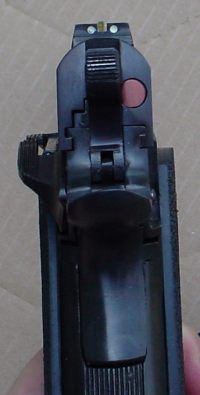 My buddy Sam, who was a
gunsmith in a former life, came over with his tools and proceeded to
give the NP28 a trigger job. Upon initial inspection of the internal
components Sam's first comment was "I never saw parts so rough before!"
After lots of stoning and installing a polished disconnector,
competition mainspring and leaf spring that I had left over from a race
gun upgrade he got the trigger down to a much smoother 5.5 lbs. With
the sear engagement at .018" he doubted he could do any better safely.
The improvement was far greater than what you would expect from simply
comparing trigger pull weights. Sam's recommendation was for Scott to
put in an aftermarket hammer and sear kit if he wanted a better trigger
pull. He also polished the feedramp for good measure, although the gun
cycled had reliably for the first couple of hundred shots. Most
aftermarket parts will work in this pistol as it is built to standard
1911 specs, except for the grip width. There is no easy way to add a
competition mag well or replacement trigger for this pistol as the
dimensions are different from the Para-Ordnance and the STI/SVI. Sam
bevelled the opening of the magazine well, but there's only so much you
can do without an add-on funnel. This slight bevel was enough to make
quick reloads vastly easier. I had a look at Roger Kotanko's Norinco at
a recent IPSC match and noticed that he had made his own heavily
funnelled magazine well for the gun and his own magazine bumper pads to
fit the unique contour of the Norinco's baseplate.
My buddy Sam, who was a
gunsmith in a former life, came over with his tools and proceeded to
give the NP28 a trigger job. Upon initial inspection of the internal
components Sam's first comment was "I never saw parts so rough before!"
After lots of stoning and installing a polished disconnector,
competition mainspring and leaf spring that I had left over from a race
gun upgrade he got the trigger down to a much smoother 5.5 lbs. With
the sear engagement at .018" he doubted he could do any better safely.
The improvement was far greater than what you would expect from simply
comparing trigger pull weights. Sam's recommendation was for Scott to
put in an aftermarket hammer and sear kit if he wanted a better trigger
pull. He also polished the feedramp for good measure, although the gun
cycled had reliably for the first couple of hundred shots. Most
aftermarket parts will work in this pistol as it is built to standard
1911 specs, except for the grip width. There is no easy way to add a
competition mag well or replacement trigger for this pistol as the
dimensions are different from the Para-Ordnance and the STI/SVI. Sam
bevelled the opening of the magazine well, but there's only so much you
can do without an add-on funnel. This slight bevel was enough to make
quick reloads vastly easier. I had a look at Roger Kotanko's Norinco at
a recent IPSC match and noticed that he had made his own heavily
funnelled magazine well for the gun and his own magazine bumper pads to
fit the unique contour of the Norinco's baseplate.
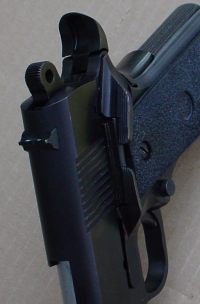 While the aesthitics of handguns is
way below their accuracy and reliability on my list of priorities, I'll
give a quick assessment and let the photos tell the rest of the story.
The external finish is quite acceptable with a decent polishing job
being done prior to bluing. The markings on the handgun reminded me of
my old dot matrix printer when it was used in draft mode. The weakest
part of the gun's cosmetics has got to be the grips. These thick slabs
of soft rubber appear to have been taken of the sidewalls of a Chinese
army truck's tires. They make the NP28's grip much blockier than it
needs to be, although throwing away the frontstrap cover helped. If
this were my pistol I'd be inclined to remove the grips and bushings
and just use pieces of shim stock and skateboard tape in the place of
any grips. If you are going to remove the bushings be very careful,
they are a metric thread pitch and incompatible with standard 1911
bushings, so if you strip the threads, you'll have a problem. At XXmm
the grip is not as wide as that on a Para-Ordnance.
While the aesthitics of handguns is
way below their accuracy and reliability on my list of priorities, I'll
give a quick assessment and let the photos tell the rest of the story.
The external finish is quite acceptable with a decent polishing job
being done prior to bluing. The markings on the handgun reminded me of
my old dot matrix printer when it was used in draft mode. The weakest
part of the gun's cosmetics has got to be the grips. These thick slabs
of soft rubber appear to have been taken of the sidewalls of a Chinese
army truck's tires. They make the NP28's grip much blockier than it
needs to be, although throwing away the frontstrap cover helped. If
this were my pistol I'd be inclined to remove the grips and bushings
and just use pieces of shim stock and skateboard tape in the place of
any grips. If you are going to remove the bushings be very careful,
they are a metric thread pitch and incompatible with standard 1911
bushings, so if you strip the threads, you'll have a problem. At XXmm
the grip is not as wide as that on a Para-Ordnance.
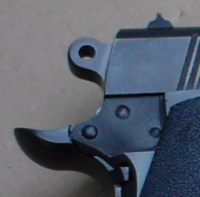 The Norinco NP28 comes equiped with an
extended, but not enlarged, magazine release that functioned smoothly
and ejected the magazines with enthusiasm. The strong thumb safety is
fairly large, and easy to rest the thumb on while shooting with a high
grip. Both sides of the frame are milled out so that an ambidexterous
safety for a 1911 single stack can be made to fit by a skilled
gunsmith. Unfortunately the cutouts aren't large enough for a drop-in
safety, without removing a lot of metal, as you can see from the photo.
The Norinco NP28 comes equiped with an
extended, but not enlarged, magazine release that functioned smoothly
and ejected the magazines with enthusiasm. The strong thumb safety is
fairly large, and easy to rest the thumb on while shooting with a high
grip. Both sides of the frame are milled out so that an ambidexterous
safety for a 1911 single stack can be made to fit by a skilled
gunsmith. Unfortunately the cutouts aren't large enough for a drop-in
safety, without removing a lot of metal, as you can see from the photo.
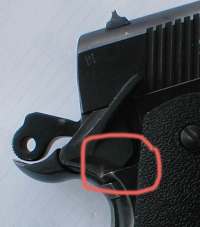 There is an extended slide lock
that harkens back to the days when people wanted extended everythings
on their guns. The beavertail is a competition style with a comfortable
shape that serves to spread what little recoil there is with the 9x19mm
cartridge. There is no 'memory groove' to ensure the grip safety is
engaged by those who use a high grip. The trigger is short and appears
to be steel. One could extend this trigger by milling the existing
trigger shoe and brazing on an extension. The fixed iron sights are of
the three dot variety with a staked in front sight that has a yellow
dot.
There is an extended slide lock
that harkens back to the days when people wanted extended everythings
on their guns. The beavertail is a competition style with a comfortable
shape that serves to spread what little recoil there is with the 9x19mm
cartridge. There is no 'memory groove' to ensure the grip safety is
engaged by those who use a high grip. The trigger is short and appears
to be steel. One could extend this trigger by milling the existing
trigger shoe and brazing on an extension. The fixed iron sights are of
the three dot variety with a staked in front sight that has a yellow
dot.
According to Alberto H. in Buenos Aires, who owns a couple of NP28s, they were very popular and cheap in Argentina (USD 230). According to Alberto the Argentine Bersa Thunder pistol's magazine is interchangeable with the NP28's. That gun is for sale in the US, and magazines are about USD 20 each. One of the main advantages you have by using Bersa´s ones, is that they hold 17/18 rounds (in countrys that trust their citizens). Archie in the Phillipines confirms that only a minimum adjustment in the hole where the magazine release fits is necessary. Bersa's owner is manufacturing some 170 mm long magazines for it - perfect for IPSC's Open Division.
Click on the thumbnail images below to see a full size image.


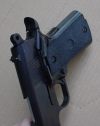
If you have any other information on these pistols, please pass it along to DaveBartlett@FirearmsTraining.ca and I'll consider posting it here.